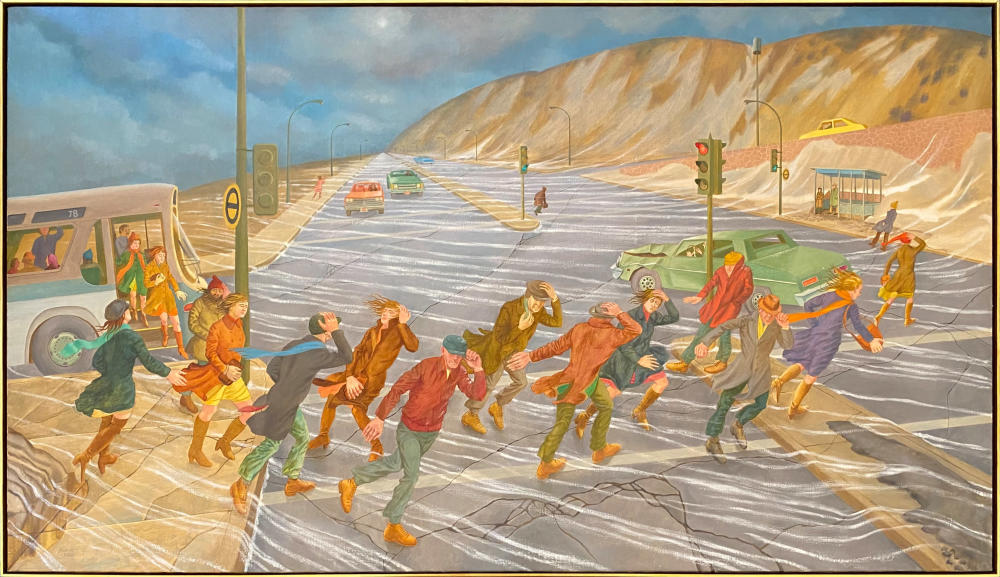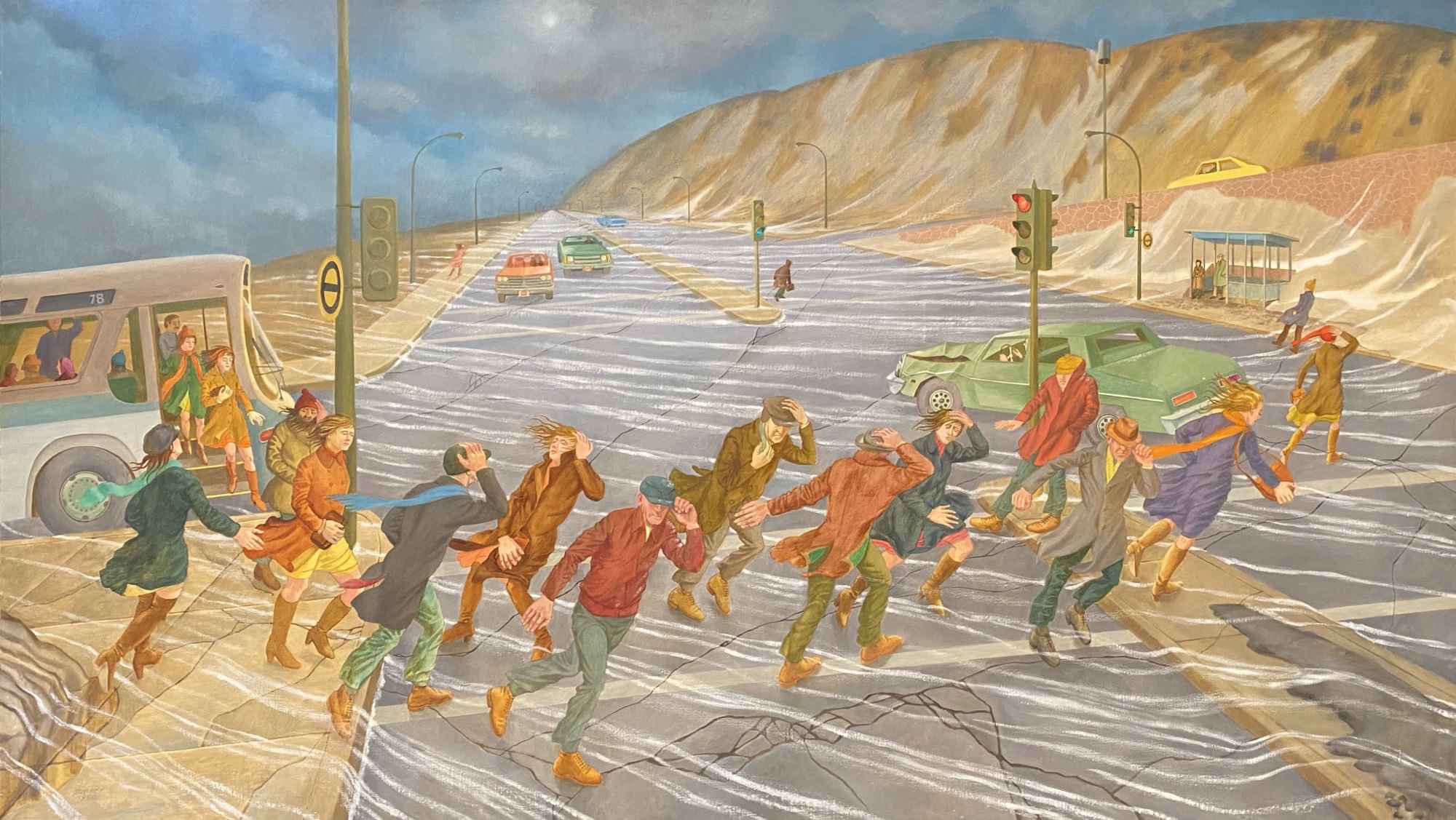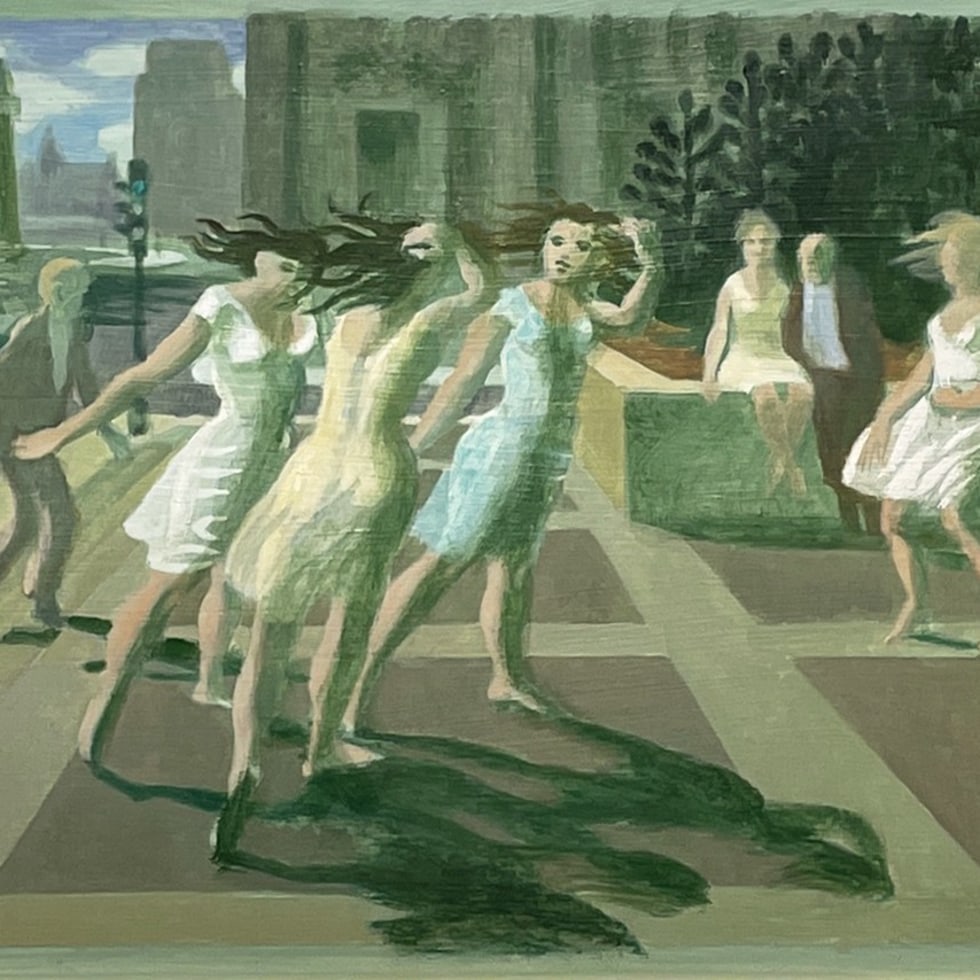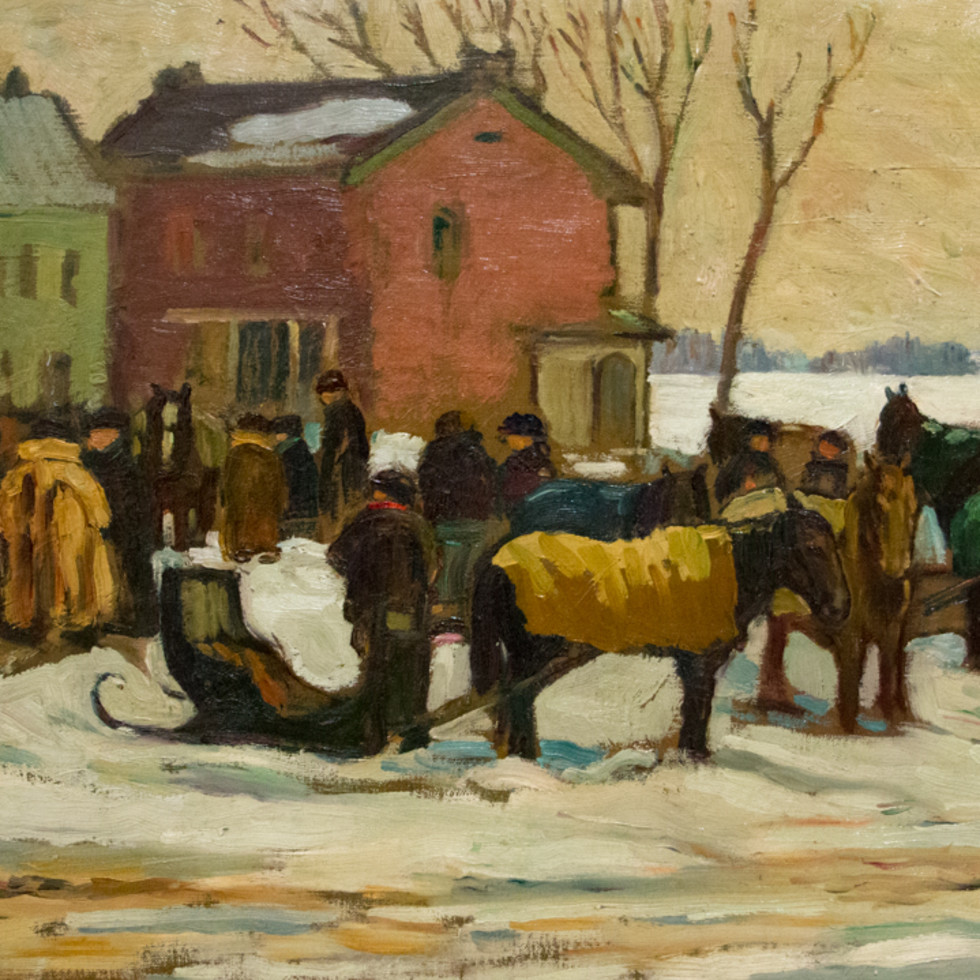Ventes notoires
March Wind (The Crossing), 1980
Oil on canvas
48 x 84 in
121.9 x 213.4 cm
121.9 x 213.4 cm
Sold
Inscriptions
signed and dated, 'SURREY / 1980' (lower left)Provenance
Private collection, Westmount, Quebec;
Private collection, Toronto, 2012.
This composition is inspired by the intersection of Montreal’s St. Remi and St. Jacques streets. Surrey’s interpretation is surreal, having entirely removed everything that is ancillary to his requirements. There is no spontaneity to his painting. Terry Rigelhof, General Editor of Discovering Philip Surrey, The Artist in the City Project, records 11 and conceivably 12 versions of this monumentally important picture executed over a period of some 5 years during which the artist worked it up to this state, the grand finale. The Musée National des Beaux Art du Québec has a full scale version painted in pastels. (fig. 1)
It is irresistible not to point out the autobiographical note of Surrey’s support of the Montreal Canadiens Hockey Club and his pride in being a Canadian. Have a close look at the license plates on the oncoming cars. Anecdotally, somewhere along my way as an admirer of this composition, someone has suggested that it is a miniscule image of the artist in the yellow car on the entrance ramp up on the right.
On what we believe to be the largest painting Philip Surrey ever painted, in March Wind (The Crossing), 1980 he addresses his definitive comments on the aspect of the human condition in his “automobile age”.
Gilles Daigneault wrote in an interview in 1979 and published in Vie Des Arts entitled L’Expressionnisme de Philip Surrey:
On this matter there is one thing that occupies a special place in the artist’s imagination and which he often uses to express what he resents most: the automobile. “At present” he says, “we are going through not the atomic age (at least not as long as each person does not have his own reactor) but certainly the automobile age.” Recent pictures like ‘The Highway’ and ‘The Trophy’ show how Surrey transforms simply disagreeable spectacles…into powerful images of the human condition… [...] Now, during our conversation, Surrey would speak frequently of his fundamental pessimism, saying that it is very difficult in our day to be lucid and optimistic at the same time.
Gilles Daigneault, now a director of the Fondation Guido Molinari, is one of the most perceptive observers of contemporary art of this generation. Exceptionally, he succeeded in drawing out Philip Surrey to express himself directly beyond anything we have read elsewhere. Among the paintings reproduced in Vie des Arts to accompany Gilles’ article is a slightly smaller version of March Wind (The Crossing).
Margaret Surrey wrote in Philip’s name that "[to live with danger] is manifested in the reluctance or inability of a person to envision his own death even though he sees the threat all around him. This trait enables us, despite the statistics of traffic deaths, to drive with peace of mind." [1]
Fast forward to June 14, 2018, Jennifer Keesmaat, CEO of Creative Housing and former chief planner of Toronto published in The Guardian.com:
"We designed Canada's cities for cars, not people – and the people are dying
Toronto’s latest toll of cyclists and pedestrian deaths is hardly unique – cities all bought the myth that cars give us freedom
Anxiety has begun to permeate everyday urban life: parents stress about their kids walking home from school; office workers check and double-check the street before rushing to a nearby cafe; cyclists act erratically when their truncated bike lanes dump them into fast-moving traffic. People are on edge everywhere." [2]
Meanwhile, automobile companies brand their vehicles with names like Explorer, Escape, Liberty and Journey. Cars are designed to look like birds and rockets, and are sold to us via multimillion-dollar ad campaigns ….. After 100 years of marketing, we have continued to believe – and want to believe – that the car gives us unfettered personal liberty.
We are not alone in having made comparisons between paintings of Philip Surrey and Alex Colville. Some years ago, strolling through a brilliant Alex Colville exhibition at Toronto’s AGO, I was struck at how appropriate one of the descriptive panels was to Philip Surrey. Relating one of Alex Colville’s paintings to the films of Joel and Ethan Coen of which it is noted the artist was a fan, it read, “...both filmmakers and artists produce undercurrents of fear, tension and the unknown, suggesting that everyday moments can tip toward calamity.” Surrey often achieves a similar temperament in his own style.
March Wind (The Crossing) is a foundation composition for an important collection of contemporary Canadian art.
_________________________________
Footnotes:
1. Margaret Surrey, Biographical notes of Philip Surrey, Philip and Margaret Day Fonds, P85A, National Archives of Canada, Estate Philip Surrey, 141.
2. Jennifer Keesmaat, “We designed Canada’s cities for cars, not people – and the people are dying”, The Guardian, 14 June, 2018 [online] 14 Jun. Accessed 24 March 2021 : https://www.theguardian.com/commentisfree/2018/jun/14/canada-toronto-cycling-pedestrian-deaths-cars
It is irresistible not to point out the autobiographical note of Surrey’s support of the Montreal Canadiens Hockey Club and his pride in being a Canadian. Have a close look at the license plates on the oncoming cars. Anecdotally, somewhere along my way as an admirer of this composition, someone has suggested that it is a miniscule image of the artist in the yellow car on the entrance ramp up on the right.
On what we believe to be the largest painting Philip Surrey ever painted, in March Wind (The Crossing), 1980 he addresses his definitive comments on the aspect of the human condition in his “automobile age”.
Gilles Daigneault wrote in an interview in 1979 and published in Vie Des Arts entitled L’Expressionnisme de Philip Surrey:
On this matter there is one thing that occupies a special place in the artist’s imagination and which he often uses to express what he resents most: the automobile. “At present” he says, “we are going through not the atomic age (at least not as long as each person does not have his own reactor) but certainly the automobile age.” Recent pictures like ‘The Highway’ and ‘The Trophy’ show how Surrey transforms simply disagreeable spectacles…into powerful images of the human condition… [...] Now, during our conversation, Surrey would speak frequently of his fundamental pessimism, saying that it is very difficult in our day to be lucid and optimistic at the same time.
Gilles Daigneault, now a director of the Fondation Guido Molinari, is one of the most perceptive observers of contemporary art of this generation. Exceptionally, he succeeded in drawing out Philip Surrey to express himself directly beyond anything we have read elsewhere. Among the paintings reproduced in Vie des Arts to accompany Gilles’ article is a slightly smaller version of March Wind (The Crossing).
Margaret Surrey wrote in Philip’s name that "[to live with danger] is manifested in the reluctance or inability of a person to envision his own death even though he sees the threat all around him. This trait enables us, despite the statistics of traffic deaths, to drive with peace of mind." [1]
Fast forward to June 14, 2018, Jennifer Keesmaat, CEO of Creative Housing and former chief planner of Toronto published in The Guardian.com:
"We designed Canada's cities for cars, not people – and the people are dying
Toronto’s latest toll of cyclists and pedestrian deaths is hardly unique – cities all bought the myth that cars give us freedom
Anxiety has begun to permeate everyday urban life: parents stress about their kids walking home from school; office workers check and double-check the street before rushing to a nearby cafe; cyclists act erratically when their truncated bike lanes dump them into fast-moving traffic. People are on edge everywhere." [2]
Meanwhile, automobile companies brand their vehicles with names like Explorer, Escape, Liberty and Journey. Cars are designed to look like birds and rockets, and are sold to us via multimillion-dollar ad campaigns ….. After 100 years of marketing, we have continued to believe – and want to believe – that the car gives us unfettered personal liberty.
We are not alone in having made comparisons between paintings of Philip Surrey and Alex Colville. Some years ago, strolling through a brilliant Alex Colville exhibition at Toronto’s AGO, I was struck at how appropriate one of the descriptive panels was to Philip Surrey. Relating one of Alex Colville’s paintings to the films of Joel and Ethan Coen of which it is noted the artist was a fan, it read, “...both filmmakers and artists produce undercurrents of fear, tension and the unknown, suggesting that everyday moments can tip toward calamity.” Surrey often achieves a similar temperament in his own style.
March Wind (The Crossing) is a foundation composition for an important collection of contemporary Canadian art.
_________________________________
Footnotes:
1. Margaret Surrey, Biographical notes of Philip Surrey, Philip and Margaret Day Fonds, P85A, National Archives of Canada, Estate Philip Surrey, 141.
2. Jennifer Keesmaat, “We designed Canada’s cities for cars, not people – and the people are dying”, The Guardian, 14 June, 2018 [online] 14 Jun. Accessed 24 March 2021 : https://www.theguardian.com/commentisfree/2018/jun/14/canada-toronto-cycling-pedestrian-deaths-cars






















